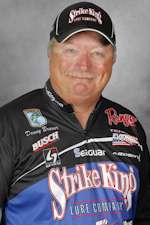It's early spring in most parts of the country. The prespawn is in full swing. The bigger females are heavy with eggs and they're feeding voraciously. Now's the time to boat the biggest bass of your life.
One of the best places to catch her is in the back of a cut, a slough, a canyon or a small inflow under a sawdust mat. Heavy spring rains wash debris from the hillsides into the water. This debris — we often call it sawdust or trash, but it's really not either one of those things — forms mats that float in shallow to middle-depth backwater areas.
Big bass love these mats, and for good reason. They offer protection, feeding opportunities and are usually located near spawning areas. That's just about everything a big bass needs at this time of the year. They're great places to fish in March, April or May depending upon what part of the country you live in.
Keep in mind that the water's still cold. Nothing is moving very fast or very far. That's why I like to flip and pitch a Strike King Denny Brauer Pro Model or Premiere Pro Model Jig.
Either one will show a big enough profile to attract the attention of a giant, but at the same time they're small enough to look natural. And they're designed so they don't drag a lot of trash down with them when they punch through the debris.
For most of my early spring fishing I go with a 1/2-ounce model. That seems to be about right. If the mat's really heavy, or if I'm looking for really big bass, I might upsize to a 3/4- or 1-ounce weight. As a general rule, however, it's best to fish with the smallest jig you can get away with. You'll get more bites that way and still have a fair shot at a trophy.
I always rig my jig with a Strike King Denny Brauer Chunk. It has very little action to it which is exactly what you want in cold water. It doesn't hang in the brush, and it slows the fall of my jig. That's a powerful combination of fish catching attributes.
Color is optional at this time of year. If you match your bait color to the water color — dark for dark, light for light — and pay attention to the prevailing forage, you'll be fine.
Fishing a debris mat isn't much different than fishing a grass mat. Your best spots will usually be at the horizontal and vertical intersections under it. (This would be a good time to review Lesson 7. It details how to find and fish intersections.)
Otherwise look for something different in or under the mat. Outsize trees or limbs, a board stuck in branches, or maybe even a different kind of wood will all attract and hold bass. Basically, you're looking for something that doesn't belong, that's out of place.
It's especially important in the spring to pay close attention to what you're doing. Many of your bites will be soft. The best description I can give you is that your jig will suddenly feel heavy, an unnatural weight that should alert you to the fact that something's going on. When in doubt, set the hook. It doesn't cost you a thing.
One final tip: Not all the bass are on the bottom. Just like in other fishing scenarios, you need to fish all the water from right under the mat on down. And don't forget to bounce your jig off the underside of the mat a time or two. You'll be surprised at how much that'll improve your catch rate.
In our next lesson, we'll talk about how to analyze your local waters.





